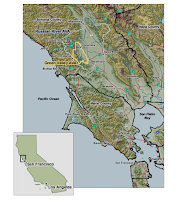The Green Valley of the Russian River Valley is cool because it lies on the edge of the Petaluma Gap meaning "that Green Valley is one of the last to have the fog burn off in the mornings, and one of the first to see it develop again in the afternoon. As such, the area's vineyards have a limited amount of exposure to bright sunlight every day, instead being subject to the cool, moist fog." The predominant soil-type is called “Gold Ridge”, a sandy loam that has excellent drainage and is perfectly, inherently balanced, making it one of the most coveted soil types, especially for growing Pinot Noir.
Iron Horse Vineyards takes advantage of this coolness and soil type and have planted approximately 160 acres of Chardonnay and Pinot Noir in the Green Valley. Their estate is divided into 39 blocks, farmed individually, harvested separately and then each vinified as a "single vineyard". They practice “precision viticulture”: Each block has been planted with site-specific rootstock and clone selections. All pruning, canopy management, irrigation, and cover crop decisions are determined on a block-by-block (and sometimes even vine-by-vine) basis, considering both the vintage and the long-term needs of the land. They use sustainable practices such as seeing hills with erosion control cover crop; mulching with grape prunings; and recycle water to frost-protect the vines as well as irrigate the gardens.The Iron Horse Vineyards Winery Block Pinot Noir 2020 is made from a single clone, Pommard 5, grown on the four acre Winery Block at the crest of the knoll below the winery and tasting room. The grapes are hand harvested, then cold-soaked in stainless steel tanks for four to seven days. Before fermentation is complete, the new wine is gently pressed from the skins and transferred to French oak barrels. Fermentation then goes to completion in the barrels, allowing us to stir the lees as the wine goes through malolactic fermentation. This process crafts a magnificent Pinot Noir where the juicy and silky black cherry fruit flows with integrity to fill the palate. Hints of spice and minerality compliment the juicy fruit.

















